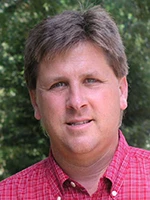
Golf Course Industry talked with Dr. Michael Richardson, turfgrass management and physiology professor at the University of Arkansas in Fayetteville about updates on large patch (Rhizoctonia solani) control.
Is there any new information that you’ve come across on large patch?
There are a couple of things that I feel are pretty noteworthy. We had a graduate student, Terry Spurlock, working on large patch as part of his masters’ degree. He was mapping the disease spatially as well as monitoring disease activity. One thing he found is that the pathogen is active a lot earlier in the fall than we previously believed and it can stay active a lot later in the spring. It may not be showing up as patch, but the pathogen is active. It can be active from the middle of August in our area to the middle of June the following year.
What does that mean from a control standpoint?
Historically, we’ve talked about a fungicide application in the fall and have migrated to maybe two fall applications. We now believe that, to get good control throughout the period the disease is active, at least one spring application is also warranted. This application is not cheap, but if you want the best possible control, it is necessary.
The patches are perennial. They come back in the same places. Once a patch is developed, it’s going to redevelop the following year in the same area unless you have gotten excellent control with the proper fungicides. Knowing that, you can save a lot of money by just treating areas that were affected previously. That is, as long as you haven’t moved the pathogen around.
That sounds like more information has surfaced. What can you say about that?
As part of the study on one golf course, Spurlock identified around a dozen patches that were being monitored. He mapped the location and measured size then and the following year. The course decided to do an earlier core aerification in late April or early May. In the monitored area, the dozen patches he was tracking redeveloped. But he also found 40 or 50 new inoculums points, or new patches developing. That suggests that the disease can be spread by core cultivation, especially if done during the time the disease is active. Now our recommendation is, if you need to core aerate a golf course, or a Zoysia lawn, do it as close to the middle of the summer as possible, when high temperatures stop the pathogen activity.
So timing is very important?
The timing of cultivation is very important. We don’t yet know about verticutting and other cultivation, but any cultivating that picks up plant material and moves it around when the disease is active has the potential of moving the disease around.
Is there anything else on cultural practices that you’d like to mention?
I get a lot of questions on nitrogen fertility and irrigation management. All of the Rhizoctonia diseases seem to be worse if there is too much nitrogen and moisture in the system. We can’t control the weather when it is cool and wet, but try to keep the N levels low, rather than high. Also, keep the surface as dry as possible to reduce the severity of the disease. Top dressing regularly to have a sandier, drier surface will help. Incorporating some organic material like compost will also provide better turf response and disease suppressive possibilities.
Latest from Golf Course Industry
- This month on Superintendent Radio Network: February 2025
- Glowing precision at Virginia Tech
- Sarasota National approves Fry/Straka course renovation master plan
- From the publisher’s pen: Hovering in the turf tech conundrum
- Zinkand Golf Design completes restoration of Old Elm Club
- Oakland University retains Wilczynski to develop master plan
- Bluewater and GEO Foundation partner for pollution and water
- Vereens adds Grill, Pruitt in Florida





